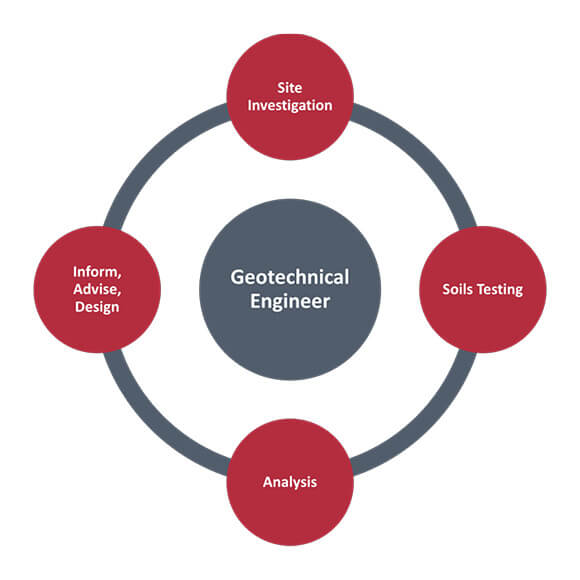Geotheta Can Be Fun For Anyone

A geotechnical engineer is a specialized civil engineer that concentrates on the actions of dirt, rock, and other products found underneath the Planet's surface area. They apply scientific principles and design methods to evaluate the homes and actions of these materials to sustain the safe and efficient style, construction, and maintenance of framework jobs.
They carry out site examinations, gather examples, do laboratory tests, and analyze data to evaluate the viability of the ground for construction projects - Consulting Engineers. Based on their findings, geotechnical engineers give recommendations for foundation design, slope security, maintaining structures, and reduction of geotechnical dangers. They team up with various other professionals, such as architects, architectural engineers, and building groups, to guarantee that geotechnical considerations are integrated right into the overall project design and implementation
By evaluating the habits and buildings of soil and rock, they can recognize potential geotechnical dangers such as landslides, soil negotiation, or slope instability. Their know-how assists prevent failings or crashes that might endanger lives and home. Right here are some comprehensive responsibilities and responsibilities of a geotechnical engineer: Website Examination: Geotechnical engineers conduct site investigations to gather data on subsurface problems.
They translate the information to recognize the residential or commercial properties and actions of the dirt and rock, including their toughness, leaks in the structure, compaction qualities, and groundwater problems. Geotechnical Evaluation and Style: Geotechnical engineers assess the data collected throughout site investigations to assess the stability and suitability of the site for construction tasks. They perform geotechnical estimations and modeling to review aspects such as birthing ability, negotiation, slope stability, lateral planet stress, and groundwater circulation.
The 5-Minute Rule for Geotheta
Foundation Layout: Geotechnical engineers play a crucial role in developing structures that can safely sustain the designated structure. They assess the soil problems and load needs to determine the appropriate foundation type, such as shallow foundations (e.g., footings), deep foundations (e.g (https://giphy.com/channel/geotheta)., heaps), or specialized techniques like soil improvement. They think about elements such as negotiation limitations, bearing capability, and soil-structure communication to develop optimum foundation designs
They evaluate building strategies, display website tasks, and perform area assessments to confirm that the style suggestions are complied with. If unforeseen geotechnical issues arise, they assess the scenario and offer recommendations for removal or adjustments to the layout. Danger Assessment and Reduction: Geotechnical engineers assess geotechnical hazards and threats related to the job website, such as landslides, liquefaction, or dirt erosion.

Cooperation and Interaction: Geotechnical engineers work carefully with various other experts associated with a job, such as engineers, structural engineers, and building and construction teams. Efficient communication and partnership are necessary to incorporate geotechnical factors to consider right into the total job style and building and construction procedure. Geotechnical designers offer technical experience, response queries, and these details ensure that geotechnical requirements are met.
Not known Facts About Geotheta
Here are some kinds of geotechnical designers: Structure Designer: Structure engineers concentrate on developing and analyzing structures for frameworks. They assess the dirt problems, lots requirements, and site characteristics to establish the most appropriate foundation type and style, such as superficial foundations, deep structures, or specialized methods like pile foundations.
They review the elements affecting incline stability, such as soil properties, groundwater conditions, and incline geometry, and create strategies to protect against incline failures and mitigate threats. Earthquake Engineer: Quake designers specialize in assessing and developing frameworks to endure seismic pressures. They evaluate the seismic threat of a website, review dirt liquefaction possibility, and create seismic style criteria to make sure the safety and security and resilience of structures during quakes.
They perform field testing, accumulate samples, and examine the gathered data to characterize the dirt residential or commercial properties, geologic formations, and groundwater conditions at a site. Geotechnical Instrumentation Designer: Geotechnical instrumentation designers concentrate on tracking and measuring the actions of dirt, rock, and structures. They set up and keep instrumentation systems that check elements such as soil settlement, groundwater levels, slope movements, and structural displacements to examine efficiency and give very early cautions of possible issues.
All about Geotheta
They have a tendency to be investigatory individuals, which implies they're intellectual, reflective, and curious. They are interested, methodical, reasonable, analytical, and rational. Some of them are also social, implying they're kind, charitable, participating, patient, caring, practical, empathetic, tactful, and pleasant - Tailings Engineer.
In the office setting, geotechnical designers make use of specialized software program tools to do computations, create layouts, and assess data. They prepare records, testimonial project specifications, interact with customers and group members, and coordinate project activities. The office setting provides a favorable atmosphere for research, analysis, and collaboration with various other professionals included in the project.
The Basic Principles Of Geotheta
They often go to task websites to perform website examinations, analyze geotechnical problems, and gather information for analysis. These gos to involve taking a trip to various locations, in some cases in remote or tough surfaces. Geotechnical engineers might carry out dirt sampling, conduct tests, and display building and construction activities to ensure that the geotechnical elements of the project are being implemented correctly.
Geotechnical designers also operate in specialized geotechnical research laboratories. In these facilities, they conduct experiments, carry out examinations on soil and rock samples, and evaluate the engineering buildings of the materials. Geotechnical laboratory designers work thoroughly in these settings, handling screening devices, operating instruments, and taping data. They work together with various other lab staff to make sure precise and reliable screening outcomes.
Comments on “Geotheta Fundamentals Explained”